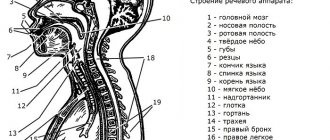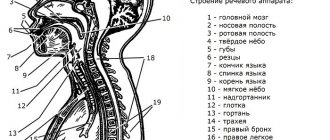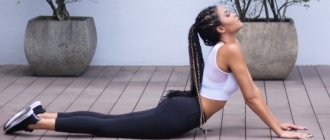Hello, dear readers! Do you know such dishes that do not break, do not break and wash themselves? “Probably some kind of nano-ware or just disposable” - you will think, and you will be wrong, because there is such a cup (C) that is always with us and has all these properties, this is an articulation exercise cup. And it is done with the tongue (I), if you don’t know how, I will teach you. The main thing is desire, patience and a lot of effort - and you will get the best h in the world.
What is the exercise for?
This exercise is very important for staging and automating many sounds. Therefore, all those who want to speak clearly, beautifully and without mistakes cannot do without it. And making hissing sounds in general is problematic if the child does not know how to fold the tongue in the right way, if it looks like a bun and the air spreads from its sides along the cheeks, and does not go out to the front teeth, as it should be normally.
In order to mold a “cup” from a “bun” you need to relax your tongue well and have visual control over the process. Therefore, it is advisable that there is a mirror of sufficient size in front of the child, allowing him to see the reflection of his face, and it is better if an adult also fits there, so that the child can see “how to do it correctly” and compare it with what he can do.
Despite its apparent simplicity, the exercise actually requires a combination of proper muscle function, their sufficient flexibility with a precisely directed air stream, which is regulated in strength and duration. I will talk about the combination itself in an article devoted to the production of hissing sounds; here we will only talk about how to achieve the desired shape of the Self and its mobility.
Speech therapy exercises for distinguishing sounds by ear
The purpose of the games and exercises below is to develop auditory attention and phonemic awareness. They help teach children to hear sounds in words, to differentiate certain pairs of sounds by ear and in pronunciation (s - z, s - c, c - ch, sh - zh, ch - shch, s - shch, z - zh, l - r ), correctly highlight the necessary words in phrases.
Games for children from two to four years old are based on onomatopoeia:
- how does a child cry? – AAA;
- How does the water flow? - SSS";
- how does a wolf howl? - UUH.
Another game for the little ones is “Song”. The speech therapist shows cards symbolizing vowel sounds - A, U, O, I in different orders, and the children sing a song.
The game of identifying the sound against the background of the word “Catch the sound” is carried out as a physical education minute. Children should jump up and clap their hands if a given sound is heard in the named word (for example [k]).
The goal of the game "Hunters" is to develop phonemic awareness. The speech therapist invites children to learn to catch sounds. He asks the children to pretend that they are sleeping (so as not to be startled by the sound): put their heads in their hands, close their eyes. Having heard the desired sound among other sounds, you need to “wake up” (sit up straight).
To set sounds in speech therapy, the “Window” exercise is used. The child is taught to keep his mouth wide open. The exercise activates the orbicularis oris muscle and the mobility of the upper lip. The child learns to lower the root of the tongue and move the tongue close to the teeth. The baby is asked to smile, open his mouth wide and move his relaxed tongue close to his teeth. You should hold the position for a count of five. During the exercise, the speech therapist makes sure that the baby’s lips are stretched, the teeth are visible, the root of the tongue is lowered, and the tongue is located symmetrically in the oral cavity.
How to learn to do it?
There are several ways to learn how to do Ch, all of them are based on relaxing certain parts of the Self. At the same time, we do speech therapy massage, as well as self-massage of the Self. One of the simplest: put a wide, soft Self on the relaxed lower lip, then ask the child to “cup the tongue.” Show yourself what it should look like.
Very often the baby cannot do this, then you need to show how to “make a hole” with your finger, resting it in the middle and stepping back a little from the tip. I have to reflexively form a cup. If this does not happen, then the tone of the Self is broken and this needs to be corrected. As I already wrote above, massage (there will be a separate article about it) and self-massage, it is available to everyone, the main thing is to do it carefully and not damage the mucous membrane.
Self-massage techniques are very easy and accessible, the main thing is to use them in such a way that they do not cause negativity in the child. Sometimes the process can take a long time, especially with dysarthria. You need to be patient and come up with a large number of gaming techniques. And don’t forget about sanitation and hygiene, keep your hands clean, rinse your mouth before and after classes, use handkerchiefs or gauze pads so that there is no direct contact with the surface.
Medical technologies in speech therapy
Biofeedback is a unique medical technology of the 21st century. It is based on the use of modern electronic equipment. The technique allows anyone to learn how to control their body and allows them to treat the following speech disorders:
- stuttering;
- speech anxiety;
- violation of the tempo of speech;
- violation of sound pronunciation (at the stage of automation of sounds and their introduction into speech);
- reading disorders.
Speech therapists use the following types of art therapy in the treatment of speech disorders:
- music therapy;
- kinesiotherapy;
- fairytale therapy;
- mnemonics;
- creative play therapy (sand therapy).
Body-oriented medical technologies used in speech therapy include stretching, relaxation exercises, and breathing exercises. Rehabilitation specialists at the Yusupov Hospital perform massage of the muscles of the peripheral speech apparatus for speech disorders. It helps to normalize muscle tone and thereby prepare the muscles to perform complex movements that are necessary when articulating sounds.
Finger massage of the palmar surfaces with stone, metal or glass multi-colored balls, clothespin massage and others are included in the rehabilitation program for patients with speech disorders. If you have a speech disorder, call the Yusupov Hospital.
Self-massage
Everyone starts with the “pancake” exercise, with the mouth wide open. First, we simply hold the I in this position for a count of 10. Then we slap the I with our lips “five-five-five” and our teeth “cha-cha-cha”, “combing” the I. We move it forward and back between the closely pressed teeth. Or we scratch it using the “slide” exercise. We “eat” the tongue - we move it back and forth between the teeth, biting it, as if we were first “chewing” it, then pushing it out of the mouth.
We make the I as wide as possible and bite his sides, either left or right. It is best to do this under the supervision of a specialist to avoid injuries and complications. You can also simply pat the protruding I lightly with your hands so that it becomes flatter and wider. In order for the baby to remember the sensations of the wide Self, it is necessary to contrast either the narrow or the wide Self. Fixing attention on how pleasant it is when the Self is relaxed and wide.
Training the muscles of the pharynx and soft palate
Speech articulation is improved by exercises that strengthen the muscles of the soft palate and pharynx:
- yawning with open and closed mouth;
- yawning with a wide opening of the mouth, noisy intake of air;
- voluntary coughing;
- imitating gargling with your head thrown back.
The child can be asked to gargle with a heavy liquid (kefir, jelly, juice with pulp), swallow water in small portions (20 - 30 sips), and puff out his cheeks with his nose pinched. You can imitate whistling, moaning, mooing.
Passive gymnastics
And we move on to passive gymnastics, when the Self is given the desired shape with the help of hands. If the child is already more or less able to expand the tip of the I, then we take it and slightly turn it back. It’s better from the “tongue tube” exercise, when the baby starts to unroll it, we try to wrap the tip. After the h begins to turn out, it is necessary to achieve its stability and lability. The most important thing is to move it behind the upper teeth.
This is very easy, but only on the condition that there are no malocclusions or dystonia. In such cases, the jaw “breaks.” We have to re-work the I position in the H shape, but this time in the form of a “sail” exercise.
Consultation for teachers “Sound gymnastics”
SOUND GYMNASTICS LOBANOV
A type of breathing exercise
Gymnastics consists of special exercises related to the pronunciation of sounds and their combination in a certain work and in a strictly defined way. Gymnastics begins with the obligatory performance of 2 exercises: a cleansing breath - “p, f, t, r” and a closed groan “mmm”.
When pronouncing sounds, vibration of the vocal cords is transmitted to the lungs, trachea, bronchi and from them to the chest; this vibration affects the bronchi and thereby helps prevent bronchitis.
Sound gymnastics is characterized by the following breathing features: inhalation through the nose (1-2 sec) pause, active exhalation through the mouth (2-4 sec), pause.
The inhalation is smooth, silent, uniform, deep. Exhale twice as much as inhale.
Sound exercises must be performed slowly, calmly, without tension, each sound must be pronounced in a strictly defined way, only then sound gymnastics gives a therapeutic result.
Vowel sounds are pronounced in the sequence - u, o, a, e, i.
Consonant sounds are pronounced in the sequence - b, d, g, v, z.
Sonorant consonants - m, n, l, r.
The exercises act like vibration massage.
For unvoiced sounds - p, t, k, f,
s
- the greatest force of articulation is required, and therefore the greatest tension in the muscles of the chest and diaphragm.
Consonant sound r
- trembling, can have from 1 to 14 vibrations when pronounced:
r
,
rrr, rrr
, etc.
Sound combinations s, r
- effective for bronchial asthma, asthmatic bronchitis.
Sound r
- pronounced energetically, loudly, in a long wave -
r
-R-R
For heart disease, the sound r
- pronounced quietly, softly, briefly.
Sounds - w - m
-
z
- pronounced with compressed lips.
Sound k
- (kh) - pronounced with lips.
Sound k
- (kh) - pronounced with a wide open mouth with intensification as you inhale.
For sound gymnastics to be effective, the following rules must be observed:
- If possible, conduct classes outdoors or in a well-ventilated area.
- The clothes are soft and loose.
- Classes are carried out before meals or 1.5-2 hours after meals, preferably in the morning. In the first 2 classes, only 2 exercises are performed - pfft
and -
mmm
- then 2 new ones are gradually added.
Carry out sound gymnastics 1-2 times a day for 5-6 minutes. Exercises can be performed sitting, standing, lying down. Before and after each exercise, take a cleansing breath - pfft
— performed quietly, lips pursed.
Following - pfft
- comes the 2nd mandatory exercise -
mmm.
- — pfft
-
mmm
-
pfft
-. - Vowels - u, o, a, e, i -
pfft. - Consonants - 1-4 - pfft
-.
- Sound combinations 1 — Mmm,
2, 3 ,4 —
pfft.
SOUND BREATHING
M.
L. Lazarev
- The effect of performing rhythmic sound breathing occurs only if the breathing is performed for a sufficiently long time (at least 3 minutes).
- Rhythmic sound breathing can be done both at rest and while walking.
- It is recommended to carry out rhythmic sound breathing most intensively in the autumn-spring period.
- It is effective to use rhythmic sound breathing while keeping a child in bed during illness.
- Rhythmic sound breathing can be used as a way to correct the mental state of children, for example, during a lesson.
The sound breathing complex is aimed at stimulating metabolic processes in cells through sound vibration. In addition, sound vibration improves microcirculation in the area of the pulmonary alveoli, stimulates the activity of the diaphragm, improves mucus drainage, relaxes the bronchial muscles, and increases emotional tone. The exercises of this complex can be performed daily.
The relaxation series (hissing) can be performed as a sound pause between any types of physical activity, as well as before bedtime. We should especially highlight the sound “s”, which has the greatest relaxing properties.
With laryngitis, only voiceless consonants are pronounced so as not to injure the ligamentous apparatus. When pronouncing long sounds, it is advisable to drag them out as long as possible.
Sound “v” (vibration at face level).
Stimulation of blood microcirculation and metabolism in the face and maxillary sinuses. The effect is achieved for rhinitis, sinusitis, and sinusitis.
I.P. - standing. The legs are stable. Eyes closed. The lips resist gently. After a deep breath, pronounce the sound “v”
until the air is completely exhaled from the lungs. The sound is pronounced quietly. It is necessary to achieve a feeling of vibration throughout the body, mainly in the face area, trying to make the sound last as long as possible. The lips must be relaxed until a “tickling” sensation appears in them. Repeat 4 times.
Sound “z” (vibration in the head and neck area).
Stimulation of blood microcirculation and metabolism in the head and neck area. Effective for tracheitis.
I.P. - standing. The body is relaxed. Eyes closed. The palm of one hand is on the front of the neck. A breath is taken. As you exhale, pronounce the sound “z” for an extremely long time, quietly. Repeat 4 times.
Sound “zh” (vibration in the chest area).
Stimulation of blood microcirculation and metabolism in
chest area. Effectively removes mucus from the bronchi and lungs.
I.P. - standing. The body is relaxed. Eyes closed. Palm on front of chest. A breath is taken. As you exhale, the sound “zh” is pronounced long and quietly .
Repeat 4 times.
The sound “m” (vibration of tissues in the chest and solar plexus).
Improving blood microcirculation and metabolism in the chest and solar plexus.
I.P. - standing. Eyes closed. Palm on the solar plexus area. A breath is taken. “m” quietly and for an extremely long time.
(deep sound). Repeat 4 times.
“F-h-ts-ch-sh-sh-s” (relaxation of all respiratory and other muscles of the body).
I.P. - lying down. Eyes closed. An even sound is pronounced, which lasts as long as possible. The sound is pronounced quietly. Repeat each sound 2 times.
SOUND PLAY EXERCISES
These exercises can be performed by children during morning exercises and in the middle of the day. In the summer, it is better to carry out the complex in the fresh air during a walk.
/. "On the horizontal bar."
Standing, feet together, hold a gymnastic stick in both hands in front of you. Raise the stick up, rise on your toes - inhale, lower the stick back onto your shoulder blades - long exhale. As you exhale, say “f-f-f-f-f.”
Repeat 3-4 times.
2. “March at a pace.”
Standing, gymnastic stick in hands. Walk with your knees high. Inhale for 2 steps, exhale for 6-8 steps. As you exhale, say “ti-sh-sh-she.” Repeat for 1.5 minutes.
3. "Pump".
Stand straight, feet together, arms down. Inhale, then tilt the torso to the side - exhale, hands slide along the body, while loudly pronouncing “ssss.”
Repeat 6-8 bends in each direction.
4. "Traffic Controller".
Standing, feet shoulder-width apart, one arm raised up, the other to the side. Inhale through your nose, then change the position of your hands and, during an extended exhalation, say “r-r-r.”
Repeat 5-6 times.
5. "Balls are flying."
Standing, hands with the ball raised up. Throw the ball forward from your chest. Say, while exhaling, a long “uh-h-h-h.”
Repeat 5-6 times.
6. “Grow big.”
Stand straight, legs together, raise your arms up, stretch well, rise on your toes - inhale, lower your arms down, lower your entire foot - exhale. As you exhale, say “uh-uh-h.”
Say 4-5 times.
7. "Skier".
Simulation of skiing for 1.5-2 minutes. As you exhale, say “mm-mm-mm.”
8. "Pendulum".
Standing with your feet shoulder-width apart, hold the stick behind your back at the level of the lower corners of your shoulder blades. Tilt your torso to the sides. When bending over, exhale and say “t-u-u-x-x-x.”
Repeat 3-4 bends in each direction.
9. “The geese are flying.”
Walk slowly for 1-2 minutes. Raise your arms to the sides - inhale, arms down - exhale, say “g-oo-oo-oo”.
10. "Semaphore".
Sitting, legs moved together. Raise your arms to the sides - inhale, slowly lower them down - long exhale, say “ssssss”. Repeat 3-4 times.
Articulation gymnastics “tea party”
We drink tea with sweets, pancakes, jam, sweet straws, and blow on tea.
- pancake - cup (we place a wide tongue on the lip, then wrap the tip in the shape of a cup)
- calyx - tube (we fold the tongue either into a tube or into a cup)
- candy - cup (we suck the tip of the tongue to the upper lip - cup)
- honey - calyx (tongue “stuck" to the upper lip - calyx)
- jam - a cup (we lick the upper lip from top to bottom, then left and right)
- cup - toffee (I in the shape of H rises up by the teeth, as if it wants to remove the glued toffee (chewing gum) from there)
- blow on tea - a cup (tapped the lip “five-five-five”, blew on tea, drank a cup)
After the child has learned to hold the Ch well, and also easily move into a tube and raise it like a “sail,” then it is quite possible to move on to the production of the upper sounds: D - T, hissing, sonors. Add breathing exercises that help you practice the direction of the blown air stream strictly in the middle. I will tell you about this in separate articles on setting R, Sh and breathing exercises.
And this is where I end this article, write your questions and comments in the comments. Share your impressions on social networks with friends and acquaintances.
Exercises to develop mobility of the lower jaw
In speech therapy, to develop speech articulation, exercises are used that promote the development of the lower jaw. These include the “Cowardly Little Chick” exercise:
- open and close your mouth wide so that the corners of your lips extend;
- lower your jaw approximately the width of two fingers;
- The “chick” tongue sits in the nest and does not protrude.
The exercise should be performed rhythmically. Then they simulate chewing with the mouth closed and open.
To perform the “angry lion” exercise, you need to lower your jaw down, extend your tongue as far as possible towards your chin and mentally pronounce the sounds “a” or “e” on a firm attack. It is more difficult to perform the exercise with whispered pronunciation of these sounds.
The child is asked to pronounce proverbs, sayings, tongue twisters, which are full of vowel sounds that require a wide opening of the mouth:
- small but daring;
- I found a scythe on a stone;
- like the fisherman, like the fish;
- the snake has a bite, the hedgehog has a hedgehog;
- a rolling stone gathers no moss.
During the exercises, the speech therapist ensures that the lower jaw drops freely downwards, and vowel sounds are first pronounced a little emphatically.






